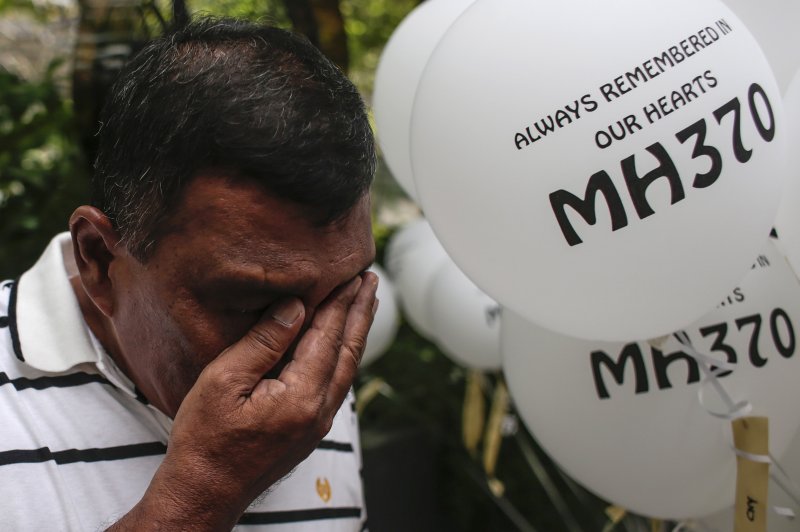Mohd Razahan cries during a remembrance ceremony in Kuala Lumpur, Malaysia, on March 6, 2016, two years after MH370 disappeared from air traffic controller's radar screens. Australia's science agency said it is "more confident" than before in estimating the location of MH370 after conducting experiments with a Boeing 777 flaperon. File Photo by Fazry Ismail/EPA
April 21 (UPI) -- Australia's science agency said it is "more confident" that it knows the location of missing Malaysia Airlines Flight 370, but Minister for Infrastructure and Transport Darren Chester suggested it would not lead to a new search.
Australia's Commonwealth Scientific and Industrial Research Organization said it analyzed drift modeling experiments of a Boeing 777 flaperon, instead of replicas to determine the plane's likely location. The first piece of confirmed MH370 debris, a right wing flaperon, was found in Reunion Island, east of Madagascar, in 2015.
"Testing an actual flaperon has added an extra level of assurance to the findings from our earlier drift modelling work," Dr. David Griffin from the CSIRO said in a statement. "Earlier drift modeling was conducted using replicas of the flaperon found on La Reunion Island. Those replicas had been made of wood and steel, and were designed to float and behave like the original."
The CSIRO's results corroborate an early conclusion by the Australian Transport Safety Bureau that determined the crash site was likely between the latitudes 40°S and 30.5°S, which placed the crash site in a 9,600-square-mile area north of the original search area.
MH370 disappeared on March 8, 2014, after leaving Kuala Lumpur International Airport in Malaysia en route to Beijing with 227 passengers and 12 crew members on board. Malaysian authorities concluded the flight ended in the Indian Ocean. Officials indefinitely suspended the search for the airplane in January until "credible new evidence" indicating a precise location is found.
"We wanted to see if the genuine flaperon drifted straight downwind like the replicas, or off at an angle, and at what speed through the water. We've found that an actual flaperon goes about 20 degrees to the left, and faster than the replicas, as we thought it might. The arrival of MH370's flaperon at La Reunion in July 2015 now makes perfect sense," Griffin said. "Knowing how the flaperon, and the other parts of MH370 that have been found, respond to wind and waves is just as important as knowing the currents of the Indian Ocean."
Australian Minister for Infrastructure and Transport Darren Chester on Friday welcomed the CSIRO report, but suggested the report alone would not lead to a renewed search, adding that "it is important to note that it does not provide new evidence leading to a specific location of MH370."
"This body of 'drift modeling' work, along with review of satellite imagery, forms part of the ongoing activities being undertaken by the ATSB in the search for MH370," Chester said.
Earlier this week, Malaysia Airlines said it became the first carrier to enlist to a satellite flight tracking system that will monitor the location of the company's fleet worldwide.















